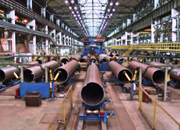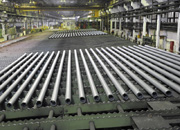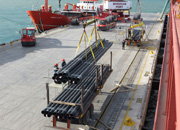Q690C seamless steel pipe, as a high-strength low-alloy structural steel material, is widely used in engineering machinery, coal mine hydraulic supports, high-pressure vessels, and other fields. Its excellent mechanical and weldability make it one of the preferred materials for heavy-duty structural components.
The core advantage of Q690C seamless steel pipe lies in its superior mechanical properties. This material has a yield strength exceeding 690 MPa, a tensile strength of 770-940 MPa, and an elongation exceeding 14%. Through microalloying design and controlled rolling and cooling processes, the material achieves both high strength and good low-temperature toughness, with an impact energy exceeding 47 J at 0℃. Its unique chemical composition design (C≤0.18%, Si≤0.55%, Mn≤1.70%, containing microalloying elements such as Nb, V, and Ti) minimizes the softening tendency of the heat-affected zone during welding, allowing it to meet application requirements without post-weld heat treatment. It is worth noting that after quenching and tempering, the fatigue limit of Q690C seamless steel pipe is increased by approximately 20% compared to ordinary Q690 steel, making it particularly suitable for working environments subjected to alternating loads.
In terms of production technology, Q690C seamless steel pipe mainly adopts a composite process route of hot rolling piercing + cold drawing/cold rolling. The hot rolling stage uses three-roll skew rolling piercing technology, with the billet heating temperature controlled at 1200±20℃. Immediately after piercing, online quenching is performed, and the cooling rate must be strictly controlled within the range of 30-50℃/s. The cold working stage employs a multi-pass small deformation process, with the total deformation controlled between 35-45% to ensure uniform microstructure. Advanced online ultrasonic flaw detection systems and eddy current testing equipment can achieve 100% non-destructive testing, with defect detection sensitivity reaching the equivalent of a Φ0.8mm flat-bottom hole. A leading enterprise utilizes a hot-rolling-cold-drawing combined production line, enabling product dimensional accuracy to reach the P5 level of GB/T17395-2008 standard, with wall thickness deviation controlled within ±5%.
In practical applications, Q690C seamless steel pipes primarily serve three major sectors: In the construction machinery sector, they are used to manufacture key load-bearing components such as crane booms and pump truck booms. For example, a certain brand's 70-meter pump truck boom, after using Q690C seamless steel pipes, achieved a 15% weight reduction while increasing load-bearing capacity by 20%. In the coal mine hydraulic support sector, they are used to manufacture columns and jacks. For instance, a certain model of support, using Q690C seamless steel pipes, increased its working resistance to 12000kN. In the high-pressure vessel sector, they are used to manufacture hydrogenation reactor shells. For example, a project using Φ426×50mm Q690C seamless steel pipes manufactured a hydrogenation reactor with a design pressure of 35MPa. Particularly in the manufacturing of wind turbine tower connection flanges, flanges made from Q690C seamless steel pipes using a ring rolling process exhibit more than three times the low-temperature impact toughness compared to traditional Q345 materials. From a market supply and demand perspective, my country's apparent consumption of Q690C seamless steel pipes in 2023 was approximately 450,000 tons, of which about 80,000 tons were imported high-end products. Major manufacturers had a combined annual production capacity of 600,000 tons. In terms of price, the current mainstream price for Φ219×20mm specifications is 8,500-9,200 yuan/ton, a premium of about 40% compared to ordinary Q345 seamless steel pipes. It is worth noting that with the trend towards lighter hydraulic supports, the annual growth rate of demand for thin-walled Q690C seamless steel pipes (wall thickness 8-15mm) has remained above 12%. The export market is mainly Southeast Asia and CIS countries, with exports increasing by 23% year-on-year in 2023.
Technological innovation focuses on three aspects: first, developing a more economical TMCP process to replace traditional quenching and tempering treatment; data from a certain factory's tests show that this can reduce energy consumption by 30%; second, developing ultra-low temperature toughness Q690C materials adapted to extreme environments of -60℃; and third, promoting intelligent manufacturing; a demonstration project achieved full-process process parameter traceability through an MES system, improving product performance consistency by 15%. With the implementation of the new GB/T1591-2018 standard, the restrictions on the yield strength ratio (≤0.93) and impact energy requirements (≥34J at 0℃) for Q690C materials will drive technological upgrades in the industry.
In quality control, leading companies have established 19 inspection processes from raw materials to finished products. Key aspects include electromagnetic stirring control for center segregation in continuously cast billets (equiaxed crystal ratio ≥45%), closed-loop temperature control during rolling (±10℃), and residual stress detection in finished tubes (≤15%σs). One company uses phased array ultrasonic testing technology that can simultaneously detect longitudinal, transverse, and oblique defects, improving detection efficiency by 5 times compared to traditional methods.
Future development trends exhibit three characteristics: first, product serialization, developing Cr-Mo and Cu-P series Q690C variant steels adapted to different corrosive environments; second, customized services, providing differentiated heat treatment solutions based on customer operating conditions; and third, expanded application scenarios, gradually replacing imported products in new fields such as offshore platform node pipes and LNG storage tank support structures. It is estimated that by 2025, the domestic demand for Q690C seamless steel pipes will exceed 600,000 tons, with high-end products accounting for more than 35%.
 Threeway Steel is known as a professional supplier engaged in manufacturing and distributing a wide range of steel pipe, and our headquarter located the central part of China – Hunan and six associated factories throughout China.
Threeway Steel is known as a professional supplier engaged in manufacturing and distributing a wide range of steel pipe, and our headquarter located the central part of China – Hunan and six associated factories throughout China.
 Threeway Steel is known as a professional supplier engaged in designing, manufacturing and distribution of a wide range of steel products with the headquarter located the central part of China – Hunan and six associated factories throughout China.
Threeway Steel is known as a professional supplier engaged in designing, manufacturing and distribution of a wide range of steel products with the headquarter located the central part of China – Hunan and six associated factories throughout China.
 Threeway Steel is known as a professional supplier engaged in designing, manufacturing and distribution of a wide range of steel products with the headquarter located the central part of China – Hunan and six associated factories throughout China.
Threeway Steel is known as a professional supplier engaged in designing, manufacturing and distribution of a wide range of steel products with the headquarter located the central part of China – Hunan and six associated factories throughout China.
 Threeway Steel is known as a professional supplier engaged in designing, manufacturing and distribution of a wide range of steel products with the headquarter located the central part of China – Hunan and six associated factories throughout China.
Threeway Steel is known as a professional supplier engaged in designing, manufacturing and distribution of a wide range of steel products with the headquarter located the central part of China – Hunan and six associated factories throughout China.
 Threeway Steel is known as a professional supplier engaged in designing, manufacturing and distribution of a wide range of steel products with the headquarter located the central part of China – Hunan and six associated factories throughout China.
Threeway Steel is known as a professional supplier engaged in designing, manufacturing and distribution of a wide range of steel products with the headquarter located the central part of China – Hunan and six associated factories throughout China.

